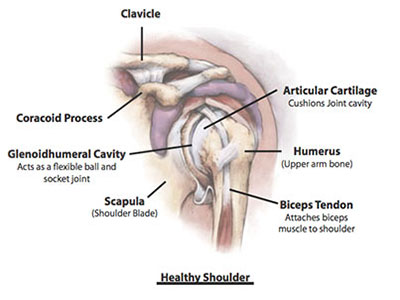Shoulder Anatomy
The healthy shoulder is a complex structure of bones, muscles, ligaments (connect bone to bone), tendons (connect muscle to bone), and cartilage. The bones that form the shoulder joint are the humerus (upper arm bone) and the scapula (shoulder blade). The top end of the humerus has a large round surface called the humeral head, which rides against the scapula in a small socket called the glenoid. Think of this connection as a golf ball on a tee. The limited contact area is what allows near unlimited range of motion in a healthy shoulder.
The humeral head and the glenoid are covered with a cushioning tissue called cartilage. Cartilage is a tough lubricating tissue that allows the bones to painlessly glide against each other. The shoulder joint is encapsulated by a group of muscles and ligaments called the rotator cuff. The rotator cuff helps stabilize the shoulder joint and provide movement.
Links to Orthopedic Shoulder Education
General
Shoulder Arthritis
Shoulder Treatment and Rehabilitation
Shoulder Injuries
- Clavicle Fracture (Broken Collarbone)
- Dislocated Shoulder
- Fracture of the shoulder blade (Scapula)
- Frozen Shoulder
- Rotator Cuff Tears
- Rotator Cuff Tears: Surgical Treatment Options
- Shoulder Separation
- Shoulder Impingement/Rotator Cuff Tendinitis
- Shoulder Joint Tear (Glenoid Labrum Tear)
- Thoracic outlet syndrome
Links are provided from the Orthopaedic connection website of American Academy of Orthopaedic Surgeons.
All patient education materials are provided by OrthoPatientEd.com and have been reviewed by our Advisory Board of leading Orthopedic Surgeons to ensure accuracy. All materials are provided for informational purposes only and are not intended to be a substitute for medical advice from your orthopedic surgeon. Any medical decisions should be made after consulting a qualified physician.
This site includes links to other websites. OrthoPatientEd.com takes no responsibility for the content or information contained in the linked sites.

